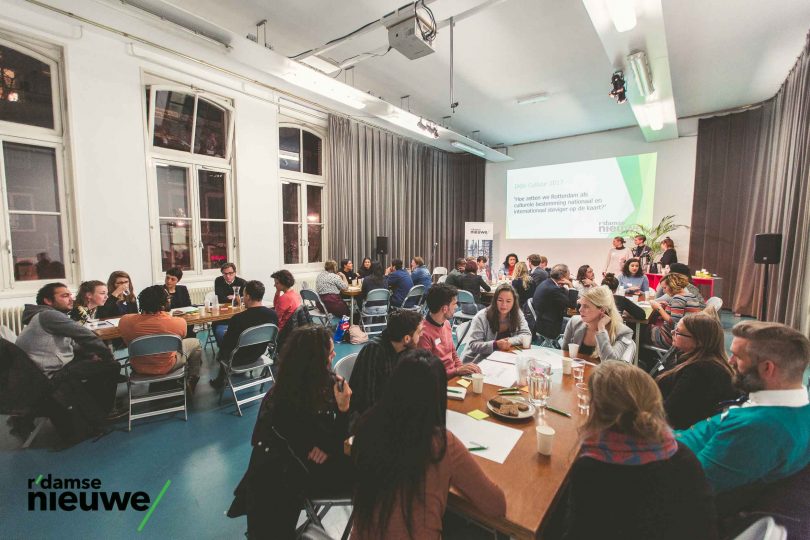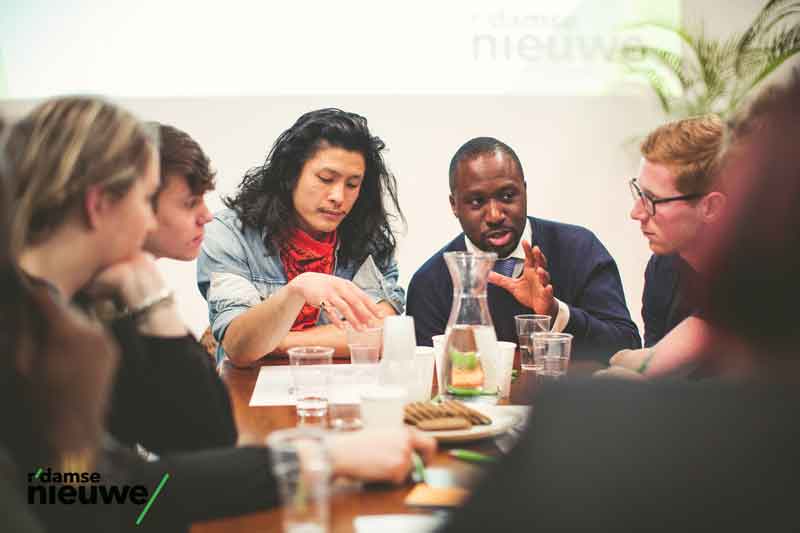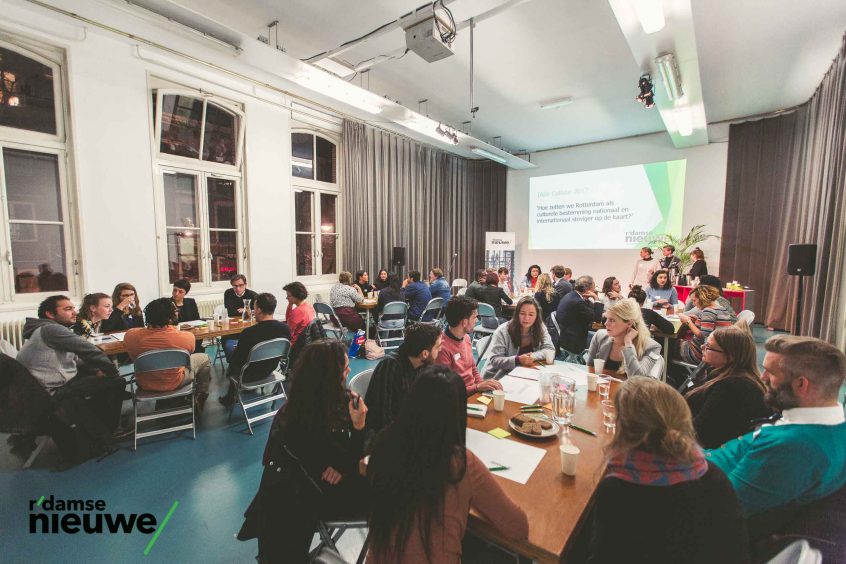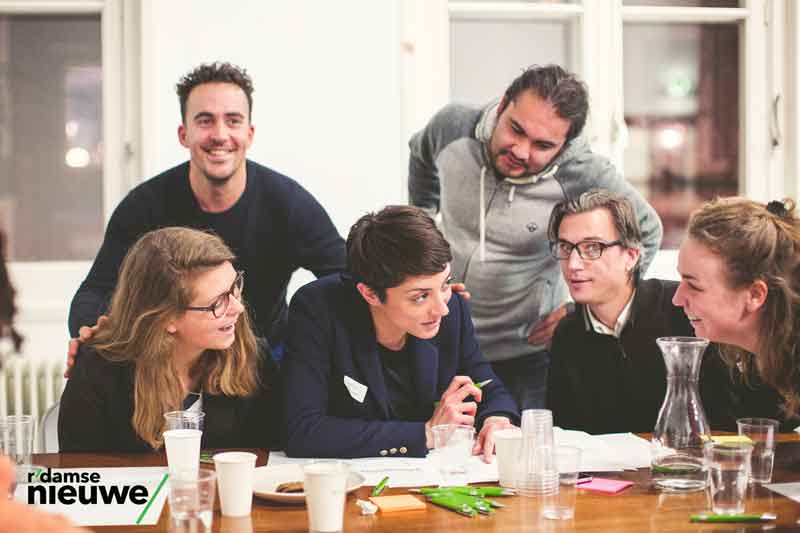Every two years Rotterdam Partners invites international experts to evaluate the city and to make recommendations stimulating economic growth. For the 2017 edition the emphasis is on culture. The experts have been asked to think about the international positioning of culture in Rotterdam. This blog was published as the R’damse Nieuwe entry in the preparation for the International Advisory Board 2017.
The main ingredients of Cultural Rotterdam from the R’damse Nieuwe perspective: mainstream, underground, the people, the architecture and the water. But how to leverage it?

When visiting a country or a city people love to wander around. Many young tourists are seeking local interactions, prefer not to see only touristic highlights but combine them with places that have that ‘authentic’ feel: those hidden spots where locals hang out. In preparation for the International Advisory Board Rotterdam (IABx) several local workgroups affiliated with culture brainstormed about their ideas on how to position Rotterdam and its cultural program internationally. However, from R’damse Nieuwe’s perspective one important group had to be included as well: young creative makers and young local consumers; the people that shape and continuously innovate the cultural field and that are often responsible for creating those ever-changing hidden gems that create that unique atmosphere in the city.
R’damse Nieuwe IABx Expertmeeting
R’damse Nieuwe is the young economic council of Rotterdam Partners. With our small board we address issues relevant to the city together with our wide network of young entrepreneurial Rotterdam citizens. In preparation for the IABx 2017 we organized a brainstorm with 50 young and diverse players in the cultural field who are active as professionals and as participants. Our main goal of the night was not to look into how we can position Rotterdam internationally. Instead, we took one step back and wondered: What is our Rotterdam? What makes the city unique and which characteristics do we want to use as assets for our international positioning? And, after defining those characteristics, which difficulties do we foresee in using those?
During the brainstorm approximately 50 young Rotterdammers helped us create a cultural profile of Rotterdam. We divided them in small groups and presented them several theses about culture in Rotterdam to get the conversation going. For example, we stated that the city needs one spectacular painting like ‘The Night Watch’ and that Boijmans, IFFR and the harbor define our cultural profile. Based on those statements we challenged them to describe Rotterdam in four main characteristics. Even though the small groups did not chose a similar language to describe their thoughts, the overall idea can be easily summarized:
Rotterdam is a diverse combination of mainstream and underground culture, and it is characterized by Rotterdammers, the water and its architecture.
But after further defining those characteristics we quickly ran into another question in line with the overall question provided as the core of the International Advisory Board 2017. We altered the starting question a bit. Our question to the international advisory board therefore became:
How can we strategically use these identity markers to create a recognizable city brand so that the international image matches the locally recognized and embraced identity?
In a second get together with a smaller group we further defined each characteristic.
Diversity
This wide variety of cultures creates a unique combination of mainstream and underground movements ranging from art, music, food, dance, festivals and much more. The mainstream organizations, such as Boijmans, IFFR, Kunsthal and De Doelen, are easy to find by tourists. Openings of new exhibitions and large events are oftentimes newsworthy and have a large international outreach. However, a lot of unique activities that give the city its vibe are hard to pinpoint, since they are operating under the radar or might not be easy to find since they are only known by smaller subcultures. A lot of those initiatives are not institutionalized, many of them are fluid, they will come and go, changing the scene as they do. This combination of polished and rough and edgy has been part of Rotterdam’s identity for decades. The challenge is: how does one align the international image with this identity? If the core of Rotterdam is shaped by all these facets, how can you incorporate this in a city brand and communicate this clearly to the international tourist?
Rotterdammers
The cultural identity of Rotterdam does not mainly consist of large cultural institutions and its spectacular architecture. It is first and foremost reflected in its inhabitants: the Rotterdammers, in all their variety: the 170 nationalities represented in the city, each with their own traditions, food, culture and subcultures that transcend borders. And proud citizens are the best ambassadors a city can wish for. However, using this as an asset for city branding is a whole new challenge. It means thinking about personal branding as an incorporated aspect of city branding. This means recognizing talent at an early stage, nurturing this and also keeping it connected to the city. This means stimulating growth and creating opportunities to keep and attract talent to the city. People and organizations such as Daan Roosegaarde, MVRDV and upcoming talents such as Sevdaliza and Stacii Samidin are great examples. But if Rotterdam is characterized by its people, then what is the next strategic step in leveraging this for international city branding purposes?
Water
The connection to water is a no-brainer. As a port city, almost every group highlighted the importance of the water, the bridges and institutions and events related to the water. Each year we celebrate the port during the Wereldhavendagen, many unused inland harbors are being transformed into incubators for water related innovation such as floating architecture whilst others create the idyllic backdrop for terraces, cafes and restaurants. However, in order to use the water as a pillar for the cultural city branding of the city, it was argued that it might be necessary to activate it more frequently with cultural programming. The connection between the city and the harbor is becoming less and less obvious, and many docks have become inaccessible for pedestrians due to recent construction (e.g. the pier facing the Erasmusbridge in front of De Rotterdam). The fact that the Maas is basically a highway for boats is not making this any easier, because it is almost impossible to initiate events while making use of the water. If the water is part of the cultural identity of the city, activities with relationship to the water should be omnipresent. How can this asset strategically be programmed and activated throughout the year?
Architecture
Rotterdam is not known for its idyllic historic houses. The contrary: after the bombing it became a playground for modern and contemporary architecture and is the only city in the Netherlands known for its skyline. The wide variety of architectural styles and eye-catching buildings tells the history of the city and also its inhabitants. The rich architectural scene with large international operating architectural firms such as OMA and MVRDV and events such as the International Architecture Biennial Rotterdam emphasize this position in the field of architecture. From this perspective the change of the National Architecture Institute into the Nieuwe Instituut (located opposite of Boijmans), is therefore still a strategic question mark. Also in this field there is a clear distinction between mainstream or well-known places such as the Markthal, the Erasmus bridge, the Rotterdam and Central Station and de Luchtsingel, and hidden places only known by connoisseurs such as SkinnyScar, DiddenVillage and het Industriegebouw. This includes the rising local emphasis on Rotterdam Zuid through initiatives such as ‘Shortcut Tarwewijk’ (a straight walk from point A to point B cutting through people’s gardens and houses in the Tarwewijk) only opens up more of the city’s history and architecture. However, there are still many underdeveloped areas with a lot of potential. Many people envision a ‘Rotterdam High Line’ (the unused train tracks on top of the Hofbogen) that could be a great addition to the city. Also the redevelopment of Rotterdam Zuid, with the development of Netherlands largest conference hall in Ahoy, there is little emphasis on the potential of this transportation hub as an international gateway with international allure for the city. With so much development in the architectural field, how can we strategically develop those underexposed areas in a way that it not only benefits Rotterdam on a local scale, but also lifts up those areas from a tourist and international perspective?

Siobhan Burger is the cultural chair for R’damse Nieuwe. In this role she took part in the preparation of the International Advisory Board 2017 and will also participate during the IABx.
All images courtesy of Mark Bolk Photo


